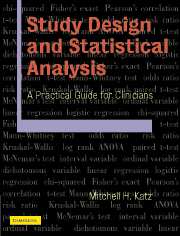Book contents
- Frontmatter
- Contents
- Preface
- 1 Introduction
- 2 Designing a study
- 3 Data management
- 4 Univariate statistics
- 5 Bivariate statistics
- 6 Multivariable statistics
- 7 Sample size calculations
- 8 Studies of diagnostic and prognostic tests (predictive studies)
- 9 Statistics and causality
- 10 Special topics
- 11 Publishing research
- 12 Conclusion
- Index
2 - Designing a study
Published online by Cambridge University Press: 05 August 2012
- Frontmatter
- Contents
- Preface
- 1 Introduction
- 2 Designing a study
- 3 Data management
- 4 Univariate statistics
- 5 Bivariate statistics
- 6 Multivariable statistics
- 7 Sample size calculations
- 8 Studies of diagnostic and prognostic tests (predictive studies)
- 9 Statistics and causality
- 10 Special topics
- 11 Publishing research
- 12 Conclusion
- Index
Summary
How do I choose a research question?
The first step in designing a study is to formulate a research question. Most clinical researchers appropriately wish to study a question in their field of practice. But knowing that you want to do a research project in a field such as HIV/AIDS or cardiology or orthopedics, is quite different than having a research question. For example: What about HIV/AIDS, are you interested in studying? Methods of preventing infection? How to diagnose infection? The prevalence of infection? Survival with HIV/AIDS? The frequency of specific HIV/AIDS manifestations?
One of the best ways to identify a research question is to determine what the unknowns are in your field. What do you and the other clinicians in your field wish you knew but don't? Perhaps your clinical experience suggests to you that a particular condition is more common in one population than another, but you're not sure if your clinical experience is typical or not. Perhaps you've evaluated a patient with a particular symptom and found that the literature lacked compelling data on how to treat the patient or what test to perform next.
Research questions may be descriptive or analytic. As implied by the name, descriptive questions focus on explaining clinical phenomena such as prevalence of disease (e.g., What is the prevalence of HIV among homeless persons?), survival trends (e.g., What is the proportion of men with prostate cancer who are alive at 5 years?), health service utilization (What is the proportion of seniors receiving influenza (flu) vaccination?), and clinical test characteristics (e.g., What is the mean value of D-dimer levels among patients who have had a venous thromboembolism?).
Information
- Type
- Chapter
- Information
- Study Design and Statistical AnalysisA Practical Guide for Clinicians, pp. 8 - 37Publisher: Cambridge University PressPrint publication year: 2006
